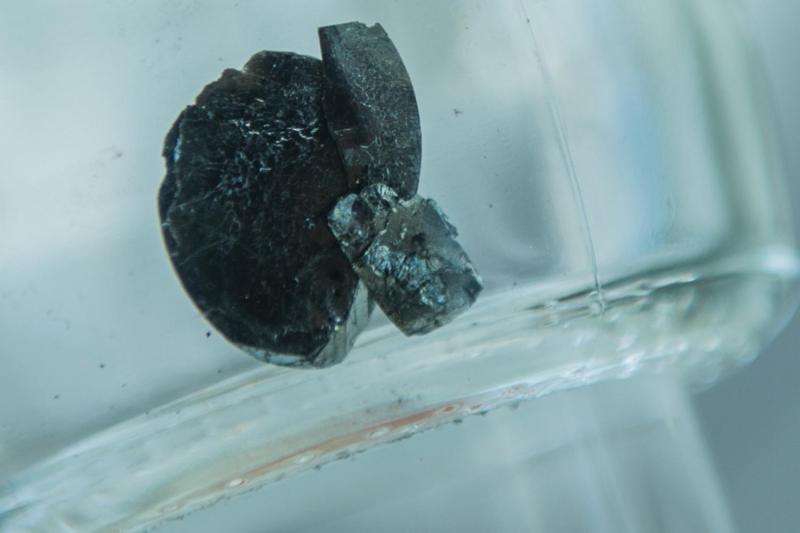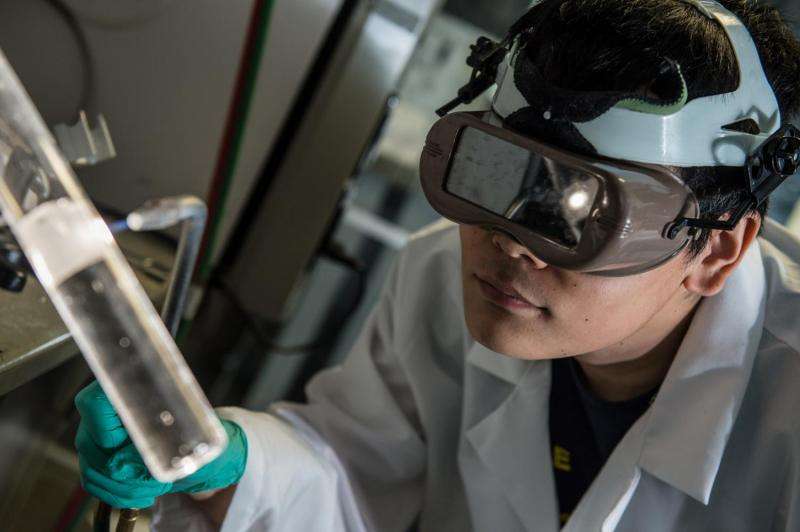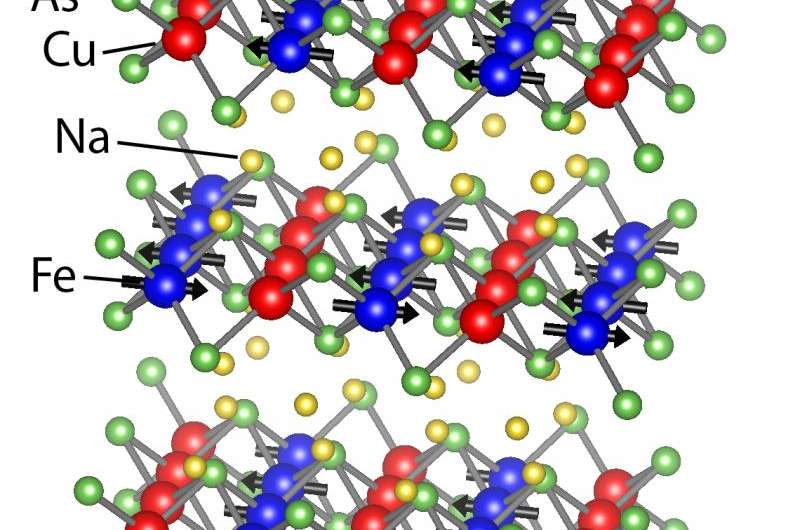Copper stripes help iron pnictide lock in insulating state

Physicists at Rice University's Center for Quantum Materials (RCQM) have created a new iron-based material that offers clues about the microscopic origins of high-temperature superconductivity.
The material, a formulation of iron, sodium, copper and arsenic created by Rice graduate student Yu Song in the laboratory of physicist Pengcheng Dai, is described this week in the journal Nature Communications.
Dai said Song's recipe—which involves mixing ingredients in a pure argon atmosphere, sealing them in niobium canisters and baking them at nearly 1,000 degrees Celsius—produces a layered alloy in which iron and copper separate into alternating stripes. This striping is critical for the material's usefulness in explaining the origins of high-temperature superconductivity, said RCQM Director Qimiao Si.
"By forming this regular pattern, Yu Song has physically removed disorder from the system, and that is crucially important for being able to say something meaningful about what's going on electronically," said Si, a theoretical physicist who has worked to explain the origins of high-temperature superconductivity and similar phenomena for nearly two decades.
High-temperature superconductivity was discovered in 1986. It occurs when electrons pair up and flow freely in layered alloys like Song's new creation. Dozens of high-temperature superconducting alloys have been created. Most are complex crystals that contain a transition metal—typically iron or copper—and other elements. High-temperature superconductors are typically terrible conductors at room temperature and only become superconductors when they are cooled to a critical temperature.

"The central problem of high-temperature superconductivity is to understand the precise relationship between these two fundamental states of matter and the phase transition between them," said Dai, professor of physics and astronomy at Rice. "The macroscopic change is evident, but the microscopic origins of the behavior are open to interpretation, largely because there are many variables in play, and the relationship between them is both synergistic and nonlinear."
Dai said two schools of thought "developed from the very beginning of this field. One was the itinerant camp, which argues that both states ultimately arise from itinerant electrons. After all, these materials are metals, even if they may be poor metals."
The other camp is the localized camp, which argues that fundamentally new physics arise—due to electron-electron interactions—at the critical point at which the materials transition from one phase to the other.
Dai said measurements on Song's new material support the localized theory. In particular, the new material is the first member of a class of iron-based superconductors called pnictides (pronounced NIK-tides) that can be tuned between two competing phases: the superconducting phase in which electrons flow with no resistance, and a "Mott insulating" phase in which electrons become locked in place and do not flow at all.

"The discovery that Yu Song made is that this material is more correlated, which is evident because of the Mott insulating phase," Dai said. "This is the first time anyone has reported an iron-based superconductor that can be continuously tuned from the superconducting phase to the Mott insulating phase."
Samples were made and some tests were performed at RCQM. Additional tests were performed at Chalk River Laboratories' Canadian Neutron Beam Center in Ontario, the National Institute for Standards and Technology's Center for Neutron Research in Maryland, Brookhaven National Laboratory in New York, Oak Ridge National Laboratory's High Flux Isotope Reactor in Tennessee and the Paul Scherrer Institute's Advanced Resonant Spectroscopies beamline in Switzerland.
"In the paper, we showed that if the interaction was weak, then even replacing 50 percent of the iron with copper would still not be sufficient to produce the insulating state," Si said. "The fact that our experimentalists have managed to turn the system to be Mott insulating therefore provides direct evidence for strong electron-electron interactions in iron pnictides. That is an important step forward because it suggests that superconductivity should be tied up with these strong electron correlations."
More information: Yu Song et al. A Mott insulator continuously connected to iron pnictide superconductors, Nature Communications (2016). DOI: 10.1038/ncomms13879
Journal information: Nature Communications
Provided by Rice University



















